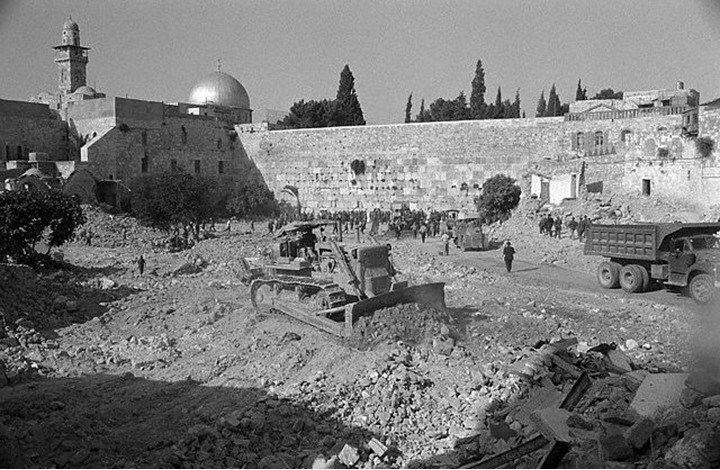Al-Sharaf District
An old residential area in Jerusalem, adjacent to the Moroccan Quarter, that was owned by an Arab family called the Sharaf family. During the British Mandate, the Jews rented most of the neighborhood and owned about 4% of it. This neighborhood was demolished during the 1948 war between Arabs and Jews, and all the Jewish residents left, and it remained unchanged during the Jordanian era. In 1967 AD, the Israelis occupied Jerusalem, and they claimed possession of this neighborhood. They expelled 3,000 of its Palestinian residents, destroyed most of its homes, and changed its name to the “Jewish Quarter”!

The Jewish Quarter is located in the Old City in the southern area of the Jerusalem Wall on the left side of the Mughrabi Gate entrance. The area of the Jewish Quarter is 122 dunums, constituting 13.6 of the area of the Old City. Al-Sharaf, on the ruins of which the largest part of the Jewish Quarter
was built, known as an Islamic Quarter, and was known in the fifteenth century as the "Kurds Quarter". As well as Islamic and atomic endowments, this neighborhood is known today as the Jewish Quarter because it constitutes a population center for Jews.
Occupation:
The first action carried out by the Jews after occupying the city of Jerusalem in the year E and م M was to seize and destroy the lane and the area was occupied four days after the occupation of Jerusalem, and thus the bulldozers of the Jews buried the Islamic Waqf lane, and the lane of honor, a neighborhood inhabited by Muslims in the old town of Jerusalem, in the lane of Honor, where the Jews expelled its people when occupied in a year ١٩٦٧ and they inhabited the Jews instead of its original inhabitants, who are Muslims .

Islamic landmarks in the Jewish Quarter
Waliullah Mohareb mosque
The mosque is located inside the wall in the honor Lane "the first Moroccan lane" and the mosque is built with a door overlooking the public street and there is a small window next to it that also overlooks the public street,and the mosque is located between several shops in that area, the length of the mosque from the inside is ٦, م M and two meters wide, and it accommodates ten worshippers and the building is tiled with marble and has a small mihrab and there is no toilet or ablution or minaret and for the speaker there is a small speaker inside the mosque that has a wire from the bazaar mosque, which it is about 250 meters away from the mosque, where the Jews attacked the loudspeaker, and there is no library or any other activities in the mosque. Only noon and afternoon prayers are held in the mosque, and it is closed the rest of the time, and for the shops belonging to the mosque, one of them was sold to Jews .
Cardo
The main commercial street from the Byzantine era, which was restored after it was revealed in archaeological excavations, and today its contents, which are located underground, are used as shops and knives .
Al-Buraq wall
The Buraq Wall is the southern section of the shorter Western Wall, it stretches between the door of the Moroccans South and the tanzian School north and has a length of 150 meters, it was named after the Buraq that the Prophet Muhammad (peace and blessings of Allaah be upon him) rode on the journey of Israel Jews began to claim that it is the remaining structure of their structure as of the first half of the nineteenth century and they called it the "so-called Wailing Wall" and in 1929 the Buraq revolution broke out in protest against Jewish attempts to control the wall that only Muslims own the wall " because it the Al-Aqsa Mosque, which is an Islamic Waqf property adjacent to a wall , The Jews destroyed the Moroccan Lane opposite it, prevented Muslims from entering it and displaced its people, turning it into a weeping square
Cohabitation in the Jewish lane
There are problems with coexistence in the Jewish neighborhood between Arabs and Jews, and this is due to the nature of the relations between the occupier and the occupiers, despite the attempts made by the Jews, such as changing the features of the honor Lane, such as changing street names from Arabic names to Jewish names, in addition to their control over some sites for some Arab sites and giving them a Jewish character .
.jpg)
